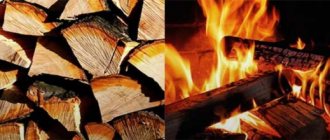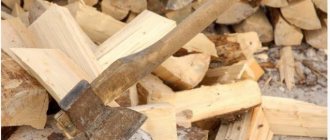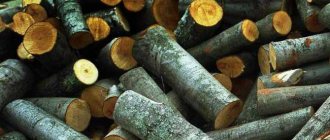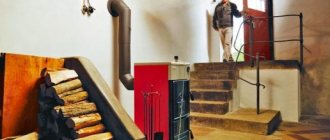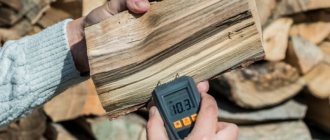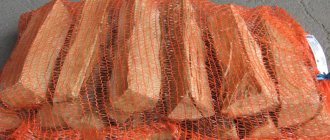Using stoves is still one of the ways to heat a home. Fire became a sign of comfort and coziness. To achieve optimal temperatures, it is necessary to select the correct material for combustion, store and select it correctly. Under unsuitable storage conditions, the material significantly reduces the energy generated during combustion.
At the same time, the heat emitted by steam or gas equipment is difficult to compare with the heat emission of a stove or high-quality firewood. Crackling sounds are heard that fill the house with comfort. No mechanical sounds are generated from the interaction of device parts with each other. Therefore, the use of stoves has not even lost its relevance even in the 21st century.
Types of the hottest firewood
The most important characteristics of firewood
Good, high-quality firewood should have the following properties:
- high flammability;
- high heat transfer;
- low ash content;
- low or medium smoke.
All these parameters depend on two factors - the condition of the firewood and the type of wood from which they are prepared. Regardless of what kind of firewood is used in a stove or solid fuel boiler, be it in a house or in a bathhouse, it must be dry.
GarryFORUMHOUSE Member
The stove or fireplace should be heated with air-dried logs with a maximum humidity of 15-25%. Only then will they burn without releasing aggressive substances and effectively provide heat.
The calorific value of firewood varies depending on the type of wood, but even logs of the same type will produce different amounts of heat in dry and wet states. With a humidity of 50%, and for freshly cut wood it can be up to 95%, the specific heat of combustion of a kilogram of firewood is one and a half times lower. Therefore, after harvesting, which necessarily includes chopping logs, the logs are stored in the woodshed for drying. On average, this process takes about two years, but some species dry faster due to the lower moisture content of the wood (birch, ash). If necessary, they can be heated raw, but still not necessary. How much firewood is needed for a season or a year directly depends on the calorific value, and it is still lower for wet ones, therefore, the consumption will be higher. The drying time is also affected by the harvesting season - in any winter firewood the initial humidity is minimal.
Birch
This is the queen of the Norwegian forests. Birch has a deservedly high rank in Norway, so high that other good varieties of trees are found in the shade and many prefer it alone.
Nevertheless, the status of the national firewood tree has a good justification: there is a lot of birch (it makes up 74% of all deciduous trees), and it grows large and even. The exception is mountain birch, which can be tortuous and difficult to fit into small ovens. But birch, growing in valleys and lowlands, if the trees are dense, forms a long trunk without branches.
From a processing point of view, birch is a lumberjack's dream compared to spruce and pine. The branches are thin, the leaves do not stick to gloves and tools like needles. In the stove, birch firewood behaves incomparably. Their combustion coefficient is high, they do not throw sparks into the room and turn into bright embers. In addition to this, birch bark ignites easily and helps with ignition.
But birch also has its own requirements: it needs to be well dried and quickly deteriorates if it is attacked by fungus and mold. If an undried birch tree is left lying on the ground, it will quickly rot.
Birch grows most actively until 50 years old and rarely lives more than 200 years. Downy birch can grow up to 20 meters, silver birch - up to 30 meters. The average density of wood is 500 kilograms of dry raw materials per cubic meter.
Wood species for firewood
If you take dry logs of different types, they differ in the intensity of combustion, and in the amount of heat generated, and in the amount of smoke produced and ash remaining after combustion. The calorific value of wood and its flammability are based on density - the denser the structure, the longer it burns and the greater the amount of heat generated. Which firewood will be better in terms of minimal ash content and low smoke production depends on its mineral composition and the presence of resins.
Coniferous species, with the exception of larch, are characterized by low-density wood and strong resinity, which is why they burn very quickly, emit little heat, and produce a lot of soot. Pine wood produces more heat than spruce, but still less than harder types, and when long-burning firewood is needed, they choose anything but coniferous. Plus, pine logs are not suitable for open fireplaces - when burned, due to the bursting resinous pockets, sparks fly in different directions. But coniferous wood also contains essential oils, which is why it is used as fuel for baths or used for kindling. And for the home, if coniferous firewood is the most accessible, it is worth heating with it, especially when the stove is cold or damp. The main species harvested for firewood are deciduous trees – both “wild” and fruit trees. The latter are especially relevant for smokehouses, as they produce aromatic smoke when burned. To prepare the famous Peking duck, the Chinese not only feed the poultry in a special way, but also use exclusively firewood from fruit trees in the process. To understand which kind of firewood is better in all respects, let’s look at deciduous wood.
Primary requirements
The best firewood for heating stoves is dry. Humidity should be within 20%. This is the main requirement. The calorific value of wood depends very much on its moisture content.
Dry wood flares up and burns well, emits more heat, and smokes less. The logs should not be rotten or saturated with water. Water logs are not suitable for heating stoves.
Good firewood leaves little ash. It is advisable to harvest wood in late autumn or winter, when sap flow stops and the wood is denser.
The size of firewood for the stove depends on the size of the firebox, usually 35-40 centimeters long. The thickness is medium, thick logs split. Small logs are easy to light. They also burn quickly, which must be taken into account when preparing them.
Birch firewood
Birch belongs to the category of medium-density wood (550-740 kg/m³), and its ash content varies between 2.43-0.52%. In terms of the amount of heat generated, birch firewood is in the leader group, since the average density is combined with initially lower, and in a dry state, minimal humidity and the presence of tar in the wood composition. However, this carbon compound contributes not only to rapid ignition and intense combustion, but also to increased smoke production with a lack of draft. If you use wet logs and the draft is insufficient, tar will settle on the walls of the chimney. When it is not possible to store and dry a woodpile for a year, but you need to select and heat it in real time, birch will become a real help. The main thing is to ensure good draft so that the wood burns on fire and does not smoke. But for pyrolysis boilers, professionals do not recommend using either wet or dry birch firewood; in this case, other species will be better. Birch bark or splinters are considered the preferred materials for lighting a stove, even if other firewood is of poorer quality.
Oak
If once upon a time alder firewood was considered royal, today the “crown” has passed to oak wood, due to its outstanding properties.
- First density category (750 kg/m³ and more).
- The first category of heat capacity (200-300 kcal).
- Long burning.
When the question arises as to what type of wood is best for heating not only the stove, but also the fireplace, oak wood often wins over others due to the characteristic odor released during combustion. In open fire conditions, this is both pleasant and useful, since aromatization occurs due to the presence of essential oils in the wood. But not everyone will allow themselves to use only oak logs for full-fledged stove heating, since they belong to the upper price segment. You can prepare some of them to put at night or in other cases when you need the longest burning possible. And the bulk of the time is heated with wood with good heat transfer, but from types that are more accessible to a wide range of people. The quality of oak firewood depends on the age of the tree - the older it is, the worse it is; it is recommended to harvest logs from trunks of medium age and size. Due to its high density, even dry oak burns quite slowly and very reluctantly. For kindling, it is more effective to use flammable resinous rocks, dried bark or birch bark.
How logs are stored
To ensure reliable storage of firewood, it must be stored correctly. The future warmth in the house depends on this. The storage area is protected from rain and snow falling on the woodpile. Fuel preparations do not need direct sunlight.
After the logs are sawed and chopped, they are left for some time in bulk in a place that is well ventilated and where the sun penetrates.
If the wood was harvested in winter, the cutting is done in the spring, so that there is time for drying and ventilation in the summer. But logs should be placed in the woodshed only at the end of summer or with the onset of autumn. When a separate shed is not provided for firewood, a base is made for the woodpile from trellises - pipes or even tree trunks of medium thickness.
The first row of logs is folded so that their ends rest on the trellises and are slightly raised above the ground. Each next row is laid at a slight angle to the previous row. You will also need vertical supports to strengthen the woodpile.
The outermost vertical rows of logs are folded alternately lengthwise and crosswise.
If there is no canopy, you need to build any shelter from the sun and rain. It can be sheet iron or slate. Sometimes they use good quality cellophane film that will withstand wind and temperature changes.
A very convenient way to store firewood for a long time is to install a woodpile in stacks.
Alder
Alder wood is the most beautiful and if you choose from an aesthetic point of view, logs of rich orange, ocher or almost red color will become an excellent decor near the stove. In terms of the amount of heat generated, alder belongs to the second, middle group, although its density is at the level of the third (up to 540 kg/m³). Like birch, the high calorific value of alder is due to the low humidity of the tree even in its raw state, not to mention dry firewood. When burning, alder logs almost do not smoke and do not emit soot at all, as they are characterized by minimal resin content. Alder firewood, wood chips or sawdust are added during smoking to give the smoke a pleasant aroma if wood from fruit varieties is not available. Fireplaces are lit together with birch and alder logs, as they do not crackle, but produce both a beautiful flame and intense heat.
To burn brightly and for a long time!
A bright flame and a minimum of smoke can only come from dry firewood.
If you follow the tips for using aspen firewood given in this article, all year round you will be able to enjoy a natural, bright fire that will warm and decorate the space around you. For owners of natural fireplaces or stoves, choosing firewood is a long and responsible process, because the comfort and convenience of all household members depends on it.
The right choice will help you enjoy smoke without soot and the unpleasant “burnt” smell that often happens when using synthetic or chemical fuel for fireplaces. Natural firewood will help not only keep you warm, but also maintain your health, because it’s not for nothing that our ancestors loved to heat the bathhouse “black” so that the smoke would be rich so that it could be inhaled, which is very useful.
Linden
Like alder, linden firewood has a low density; it is also in the third group and produces less heat - at the level of spruce or poplar wood. Linden, rather from the section on what kind of deciduous firewood is better not to use for heating a house, since the output from them is small and they burn quickly. Consequently, much more of this wood will have to be prepared, and the ash pit will have to be lined and cleaned much more often. Such fuel is unprofitable both financially and unattractive in terms of labor intensity - first the logs will have to be chopped, then the logs will have to be stacked, and then constantly brought in. But when choosing firewood for a bathhouse or for a fireplace, this breed attracts with its aroma, and is even positioned as medicinal. Knowing which firewood is more effective for heating the stove, and which can and should be used for other purposes, you can actually prepare the optimal supply.
Video description
See the video for what improper storage leads to:
For fireplaces and pyrolysis stoves, it is advisable to further dry the fuel by keeping it in a warm and dry place for several days. The “cleaning” firewood – aspen and alder, used for cleaning chimneys – should also be well dried.
It is advisable to harvest oak in advance and put it into use after a year or two - this is the time it takes for the wood to dry. Birch, on the contrary, is used in the year of purchase. Linden is stored for no longer than 2-3 years if you want to enjoy its amazing aroma in the bathhouse.
Aspen
Aspen firewood is at the bottom of the rating both in terms of density and calorific value, but it burns without smoke, without soot, and without soot. On the contrary, they are used to clean the chimney, since the vapors released by wood during the combustion process can settle on the sooty walls and corrode soot deposits. If you use aspen for periodic burning, it will be much easier to maintain the chimney in working condition. It will not be possible to completely get rid of the need for periodic maintenance, but it is possible to reduce the number of approaches and labor costs. You can also light a stove with aspen splinters; they set quickly. When choosing what kind of firewood will be needed in large volumes, aspen is definitely not in the top. It is enough to prepare a dozen or two logs of it, but if the stove is not only in the house, but also in the bathhouse, and there is also a fireplace, the reserves should be increased.
Beech, ash
In terms of calorific value, beech and ash belong to the first group - they burn for a long time, they give a lot of heat, even if they have lain for only a month or straight from the ax into the oven. Like oak, due to their hardness and density they are reluctant to flare up, but they maintain combustion for as long as possible, due to which less of them are required. But if ash is even more or less available, burning it with beech is an expensive pleasure that should be left for the fireplace or in case of severe frosts.
What are the alternatives?
In addition to the types of wood listed above, peat briquettes are popular. Their advantage is that they do not need to be chopped, dried or otherwise prepared for burning.
Sawdust can be used instead of lump wood. But you still need firewood. With their help, kindling is carried out, followed by sawdust, which should make up no more than a third of the total volume of fuel.
From fruit trees
The brushwood obtained from regular pruning of garden trees can also be used as firewood, especially if you “bundle” logs from it and light the stove in a cold house. If we consider specifically “fruit” firewood, which is better also depends on density, and in terms of this indicator, middle-aged apple and pear trees win. However, you can very rarely find them on sale and not in all regions, unless you have to uproot trees from your own garden. It is worth using such valuable firewood either for the fireplace, so that the house has a pleasant smell, or for the bathhouse for the same reasons, but it is more advisable to leave it for the smokehouse or barbecue.
Exotic
As you know, there are quite a lot of tree species, and to list all their types, you could write a thick book, or even more than one.
Therefore, in addition to the varieties listed, it is worth touching on at least a few more:
- Elm. It produces a lot of smoke, is difficult to split and takes a long time to ignite.
- Poplar. Like firewood for a stove - nothing at all. They prick easily, just scatter sparks and burn quickly.
- Beech. It is also difficult to light and split, but can be used raw.
- Fir. Like poplar, it is easy to prick and ignite, but you cannot do without a lot of smoke and sparks.
- Sycamore. Wood is easy to kindle, but difficult to split.
Poplar, willow
If fruit firewood is not widely used due to its rarity, heating with poplar or willow wood is simply not practical. They emit minimal heat and burn almost instantly; to warm up the stove, not to mention the house, you will need more than one load. Even taking into account the bargain price or the opportunity to collect poplar trunks for free, after the utility workers, when choosing what kind of firewood to burn, it is not worth considering. Only when there are absolutely no other options, you can “stand still” with such firewood for some short time until you can prepare or buy good ones.
